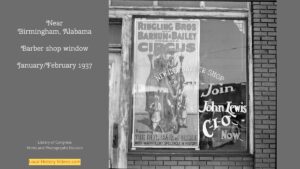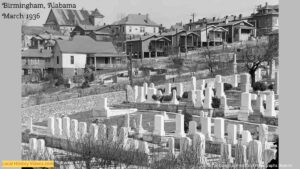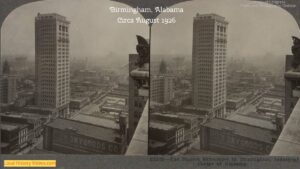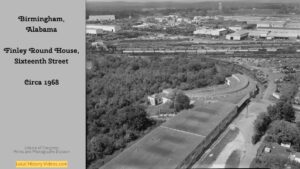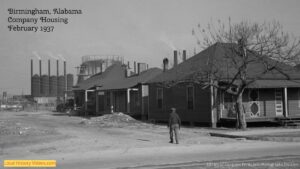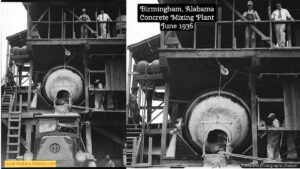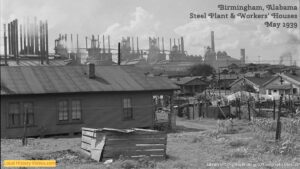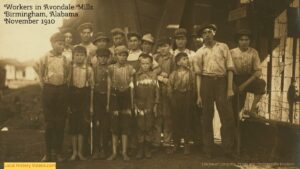By 1926, Birmingham, Ala., was at the height of its industrialization and a dynamic, modern place to be.
In 1926, Birmingham, Alabama, was a city in the midst of significant industrial growth and cultural development, reflecting both the opportunities and challenges of the time. Established as a major industrial center, Birmingham had already earned its nickname, the “Pittsburgh of the South,” due to its prolific steel and iron production. The year 1926 marked a period of transition for the city, highlighted by its economic strengths, social dynamics, and infrastructural developments.
Economic Landscape
By 1926, Birmingham was at the height of its industrialization. The city’s economy was predominantly based on the iron and steel industries, with major companies like the Sloss-Sheffield Steel and Iron Company and Tennessee Coal, Iron and Railroad Company leading production. The availability of rich natural resources, including coal, iron ore, and limestone, had fueled this growth, and workers flocked to the city for employment opportunities. Birmingham’s factories produced not only steel and iron products but also other materials necessary for construction and the burgeoning automobile industry.
Despite the booming industrial economy, Birmingham faced challenges characteristic of the era. The economy was beginning to show signs of strain as it approached the Great Depression, which would begin in the following years. There were growing concerns about labor rights, with increased organization among workers demanding better wages and working conditions. This was an era of intense labor activism, and Birmingham was no exception, as various unions began to assert their influence.
Demographics and Society
In 1926, Birmingham’s population was diverse, with significant numbers of African Americans who had migrated to the city during the Great Migration, seeking job opportunities and better living conditions. This demographic shift contributed to a burgeoning cultural landscape, particularly in music and the arts. The city was a focal point for the African American community, and cultural institutions began to emerge during this time.
However, Birmingham was also a deeply segregated city, with racial tensions simmering beneath the surface. Jim Crow laws enforced racial discrimination in public facilities, schools, and housing, leading to stark divisions in living conditions and opportunities for African Americans compared to their white counterparts. This social landscape set the stage for future civil rights movements, which would gain momentum in the following decades.
Infrastructure and Urban Development
The infrastructure of Birmingham continued to develop rapidly in 1926. The city saw improvements in transportation, including the expansion of roads and railways, which facilitated the movement of goods and labor. The construction of bridges and public buildings reflected the city’s growth and aspirations for modernization.
Notable projects during this period included the ongoing development of the Birmingham-Jefferson Civic Center, which would eventually become a hub for cultural and civic events in the city. The burgeoning skyline was characterized by a mix of industrial buildings and early skyscrapers, contributing to the urban aesthetic of the time.
Cultural Life
Culturally, Birmingham in 1926 was vibrant, with a growing arts scene, including music, theater, and literature. The city hosted various entertainment venues, dance halls, and theaters showcasing jazz, blues, and popular music. The influence of the African American community began to permeate Birmingham’s cultural fabric, setting the stage for future musical movements.
Additionally, this was a time when the local newspaper, the Birmingham News, played a crucial role in disseminating information and shaping public opinion on social and economic issues, including labor rights and racial inequalities.
More about Alabama
- Labor Rights in Old Birmingham, AlabamaThe labor movement in Birmingham, Alabama, has been a significant part of the city’s industrial history, characterized by a struggle for workers’ rights, labor organization, and social justice.
- Birmingham, Alabama in the 1930sStep back in time to 1930s Birmingham, Alabama, a vibrant city struggling with the impact of the Great Depresssion.
- Birmingham, Alabama in 1926By 1926, Birmingham, Ala., was at the height of its industrialization and a dynamic, modern place to be. In 1926, Birmingham, Alabama, was a city in the midst of significant industrial growth and cultural development, reflecting both the opportunities and challenges of the time. Established as a major industrial center, Birmingham had already earned its… Read more: Birmingham, Alabama in 1926
- The Finley Roundhouse at Birmingham, AlabamaThe Finley Roundhouse was an important part of railway history in Birmingham, Alabama. Abandoned and derelict, its roof was destroyed by a hurricane.
- Company Housing in Old Birmingham, AlabamaAs workers migrated into the expanding city of Birmingham, Alabama the company houses were in high demand.
- Making Concrete in Old Birmingham, AlabamaConcrete was an essential part of growing the city and industries of Birmingham, Alabama.
- The Steel Industry in Birmingham, AlabamaDiscover why steel was such an important part of the local economy in Birmingham, Alabama, USA.
- Old Photos of the Workers of Mobile, AlabamaGlimpse history through old photos of adults and children at work in Mobile, Alabama, USA.
- The Child Workers of Birmingham, AlabamaDiscover the haunting old photos of children who worked in the factories, eateries, messaging and transportation industries of Birmingham, Alabama.
- Old Images of Mobile, AlabamaGlimpse history through old images of Mobile, in Alabama, USA.


